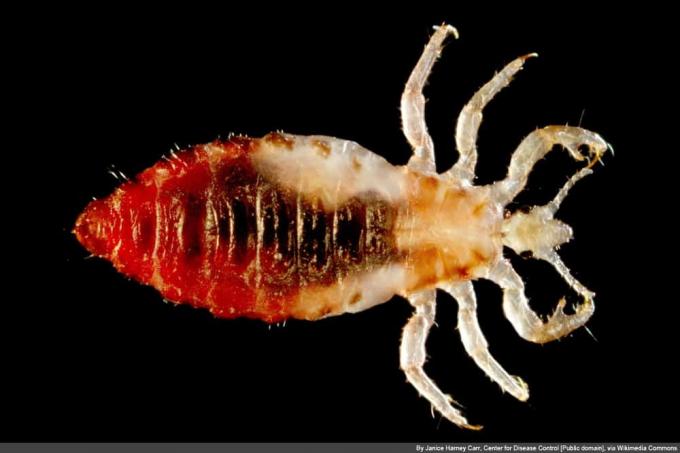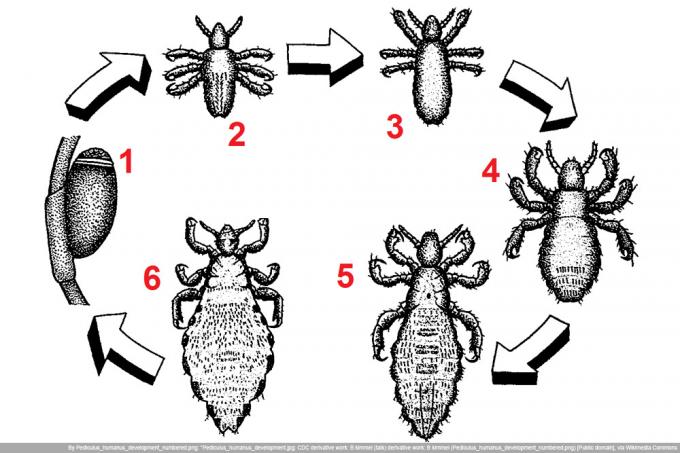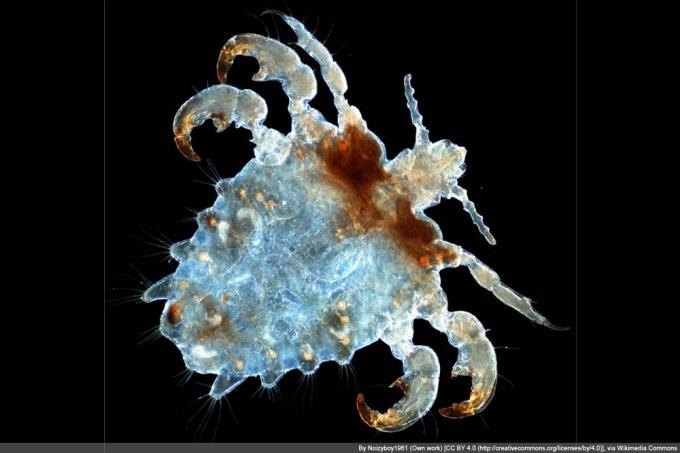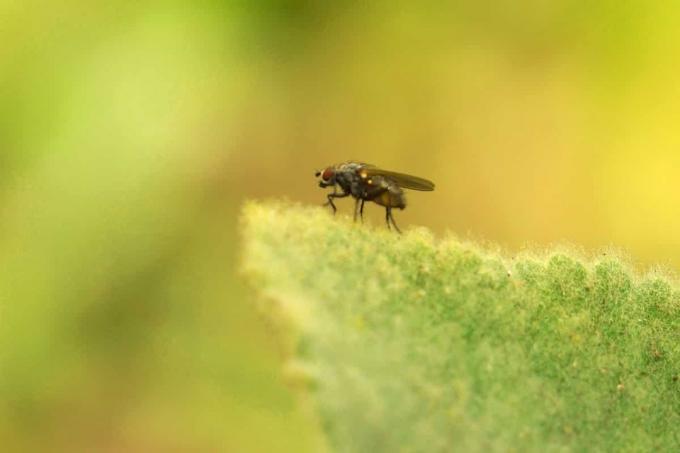

Table of contents
- appearance and behavior
- Typical symptoms
- Recognize clothes lice - this is how it works
- Common routes of transmission
- Health hazard potential
- Effective combat
- Hygiene is the best protection
When intense itching robs you of a good night's sleep, clothes lice are at the top of the list of suspected culprits. It is of little consolation to those affected that the parasites have become rare. An infection with the bloodsuckers should not be taken lightly, because body lice transmit dangerous diseases. Here you can find out how to recognize and effectively combat body lice.
appearance and behavior
Clothes lice are human lice and are very likely to have evolved from head lice. When humans lost their body hair in the course of evolution and wrapped themselves in clothing, this was the starting signal for the development of the body louse. The parasite is specialized in humans and feeds exclusively on blood. Its preferred locations are the seams of clothing and laundry in regions close to the body. Therefore, clothes lice are also referred to as body lice. The bloodsuckers only leave the warm, cuddly retreats within their clothing to eat a blood meal several times a day and night. As the largest species of human lice, Pediculus humanus humanus can be spotted with the naked eye. These are the characteristics of clothes lice:
- Length: 3 to 4.5 mm
- Color of adult body lice: brownish to whitish-yellow - rust-red after a blood meal
- Color of lice eggs (nits): white to cream
- Whereabouts: on hems and seams in a rosary-like arrangement
- Locomotion: crawling (cannot fly or jump)
Once body lice have established themselves on a person, they multiply explosively. Females are sexually mature after 14 days at the latest and are about 40 days old. During this time, they lay an average of 10 eggs per day. The lice stick these with waterproof putty in the seams and hems of clothing in the form of long strings of pearls. The warmer the ambient temperature, the faster the fatal development progresses. Clothes lice develop their maximum activity at 27 to 30 degrees Celsius. Then the beasts move at 23 cm per minute. From around 40 degrees Celsius it gets too warm for the bloodsuckers and from around 5 degrees Celsius it gets too cold.
Typical symptoms
Severe, persistent itching is the first symptom of a body lice infestation. Infected people are tormented with it, especially at night. It is unbearably itchy, primarily in areas close to the body, such as under the armpits, on the waistband or in the genital area. But the parasites also bite at all other parts of the body to suck up the blood. Only the head is spared and reserved for the smaller head lice.
As a further sign, the bite areas initially turn reddish. Since the victims cannot resist the itching for long, line-shaped scratches form as a result and that typical appearance of a 'vagrant skin' with numerous tiny scars surrounded by light and dark ones discoloration. Since bacteria and fungi get into the skin via the scratches, eczema is also a widespread consequence.
Recognize clothes lice - this is how it works

If the symptoms indicate an infestation with clothes lice, act immediately and see for yourself. How to track down the parasites:
- Provide good lighting
- Examine clothing and itchy skin with a magnifying glass
- Examine armpit hair and other body hair with a lice comb (nit comb).
Look out for red bite marks, moving body lice and whitish strings of lice eggs. If the scales seem to be stuck, you are often dealing with nits.
Common routes of transmission
Although clothes lice cannot fly or jump, they are extremely contagious. Wherever people are not so particular about personal hygiene or where there is a lack of sanitary facilities, the parasites easily move from host to host. These transmission routes have emerged:
- Close physical contact
- Shared clothing, such as sweaters, t-shirts, trousers and other textiles
- Laundry used collectively, such as towels, sheets or blankets
- Unclean mattresses and beds
- Clothing from the second-hand shop or the clothing store
- Dirty headrests and buses and trains
- Rare on paper money or in antiquarian books
While clothes lice have become very rare in everyday life in Europe, the parasites are common in crisis areas and mass accommodation. Therefore, body lice are a feared problem in homeless shelters and refugee shelters.
Tip:
Are you staying in mass accommodation or crisis areas voluntarily or professionally? Then you prevent the bites from clothes lice. Waterproof all your clothes and laundry with a detergent that is also used to protect against mosquitoes, such as Nobite Clothes or Nobite Thinner.
Health hazard potential
As if excruciating itching and painful eczema weren't bad enough, body lice bites pose a significant risk to your health. History tells us that Napoleon lost more soldiers on his campaigns to lice and the diseases associated with it than to gun violence. It is not the bites and stings that pose the risk of infection. When body lice are crushed by scratching, their excrement enters the skin via the wound and can cause the following diseases:
- Typhus exanthematicus with a mortality rate of up to 20 percent
- Wolhynic fever, trench fever (Bartonella quintana), associated with severe pain and high fever
- Relapsing fever, lice relapsing fever (Borrelia recurrentis) with repeated, strong fever episodes
While trench fever and relapsing fever are now very rare, spotted fever is still of outstanding importance today. For this reason, any infestation with clothes lice as the main carrier must be reported to the health department immediately.
Tip:
From a medical point of view, an infestation with clothes lice is fatal. From a cultural-historical point of view, human lice are a stroke of luck. The point in time when head and body lice genetically differentiated is the only clue for dating the first human clothing to 110,000 years ago.
Effective combat

The effective fight against clothes lice is based on a combination of disinfection and maximized hygiene conditions. Body lice do not live directly on a person, so the entire environment must be included in the treatment. Fortunately, remedies for common head lice are just as effective against body lice, as the two parasites are closely related. How to successfully fight body lice:
- Wash clothes, laundry, bedding, towels at 60 to 90 degrees or dry clean
- Then disinfect with an allethrin-based anti-lice agent, such as Jacutin Pedicul Spray
- Put non-washable textiles in a plastic bag and place in the freezer for 1 week
- Alternatively, keep infected clothing airtight for at least 4 weeks
- In an emergency, burn heavily infested clothing and fabrics
Allethrin destroys all types of lice, such as body lice, head lice and pubic lice. The contact poison paralyzes the muscles of insects, causing them to suffocate. Experience has shown that one application is sufficient to destroy adult body lice and their nits. Please read the instructions for use carefully to avoid treatment errors. If the infestation with body lice is only discovered at an advanced stage, we recommend the use of a professional pest controller who will disinfect all premises.
Tip:
You can treat bites from clothes lice with remedies that are also effective against mosquito bites. These include pens and gels, which primarily relieve the itching. Healing without chemicals is possible with a thermoelectric bite healer, like Bite-away, which fits in every handbag.
Hygiene is the best protection
In contrast to head lice, an infestation with clothes lice is a clear indication of poor hygiene. Don't let it get to that point. The dangerous body lice cannot stand meticulous cleanliness and consistently avoid well-groomed people and sparkling clean locations. Change your clothes at regular intervals. Wash or clean textiles, upholstered furniture and mattresses regularly. Avoid close physical contact with people who are obviously neglecting their personal hygiene. If you buy clothing in a second-hand shop or are dependent on the clothing store, please wash all items thoroughly before wearing them for the first time.
 garden editorial
garden editorial I write about everything that interests me in my garden.
Learn more about home pests

Drive away cockroaches: leave the light on at night?
Cockroaches are among the most disgusting pests that can appear in living spaces. But the disgust factor is only one side of the coin. The other is that the crawlies contaminate food supplies with pathogens. It is therefore essential to declare war on insects. Can cockroaches be repelled by leaving the light on at night?

Spotting mites in bed: 9 signs of bed mites
Mites are found everywhere in the home. Even in a clean, well-groomed bed, millions of animals can be found. This is not only a problem for allergy sufferers, but can also cause allergies.

Identify cockroaches: what do cockroaches look like?
Cockroaches are disgusting, everyone agrees on that. Worse still, they nibble at our food supplies and leave behind disease-causing germs. Because cockroaches flee and hide at lightning speed, we rarely see them. But then everyone should recognize them immediately.

Electric spider in the house: how to get rid of it
A thin body and long, thin legs characterize the electric spider. It got its name because it trembles when touched. The insect likes to stay indoors. Read how to banish the unwanted guest from your apartment.

Caution hantavirus: properly remove mouse droppings
Anyone who lives in the country, maybe keeps animals or who is often out and about in the forest is at risk from so-called hantaviruses. These are transmitted by mice and their droppings, so you should take extra precautions when removing them.

Fight houseflies: 10 remedies & tips
The housefly can be fought with various traps that have been prepared with attractants. Adhesive surfaces or liquids ensure that the insects can no longer escape. In addition, there are simple measures to keep the annoying flies out of the apartment.


